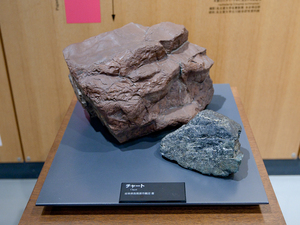Nagoya City Science Museum
TOP > Exhibition Guide > Keyword Search > Starting with "C" > chert > Chert
Chert



Purpose of Exhibition
This exhibit is designed to stir up awareness to stop and think that ordinary rocks in your everyday life surroundings may hold the key to probing into the past Earth's environments.
Additional Knowledge
You will find a large area of exposed reddish brown rock surfaces when you visit the Inuyama region (located in the suburbs of Nagoya) famous for what they call "The Nippon Rhein Cruise" (named after Germany's Rhein River) where you can enjoy a thrilling boat cruise down the rapid-stream Kiso River. In fact, that's where a globally crucial discovery was made.It is generally known that some 245 million years ago, there occurred a disaster where 96% (extinction rate of marine invertebrates) of life on the Earth became extinct. Familiar trilobites went extinct in that era. However, it had long been an enigma what had caused the massive extinction of life. Scientists around the world continuously searched for evidence to delve into the cause of it.
Photo 1: ExhibitThe Inuyama region has a geologic stratum distribution of that era, most of which is chert. Chert is a sedimentary rock that is formed from the shells of microscopic marine life in deep ocean environments.Chert is a rock, which is formed from the off-shore deep ocean bottom sediments made of the shells of planktons called "radiolarians." It is so hard that it was once used as flint. Nowadays, it is used as a garden stone or gravel and is often seen here and there in our everyday life environment. Widely distributed in the Inuyama region are reddish brown cherts, among which some blackish ones are also present. Furthermore, some in-depth researches have tracked down the fact that the stratum was black in the era of the massive extinction of life.The reddish brown is similar to the color of iron rust. The reddish cherts contain a trace of iron in the form of hematite (Fe3) and are, therefore, reddish. On the other hand, the blackish cherts have a content of iron as pyrite (Fe2). Hematite is an ore that occurs in a state of oxidation while pyrite occurs in a state of reduction. More specifically, it is conceivable that oxygen was plentiful when the reddish cherts accumulated and scanty when the blackish cherts did.That may allow us to figure out that oxygen was scanty in the era when the massive extinction of life occurred. As mentioned hereinbefore, the cherts were formed at the off-shore deep ocean bottoms. Considering that the huge ranges from the Continents to the remote off-shore ocean bottoms were deficient in oxygen, very possibly the entire global environment suffered from oxygen deficiency in that era. And what is worse, that oxygen deficiency is presumed to have continued for as long as 10 million years or so. In this connection, a theory has sprung right from the Inuyama region that the oxygen deficiency was the very cause of the massive extinction of life and is currently under discussion.Well, then. What caused the entire Earth to suffer from oxygen deficiency in that era? Unfortunately, no definite answer is available as yet. But in essence, a process called "continental drift" is considered to be responsible for it.Such an aspect of the Earth's history is carved into just ordinary rocks.
Photo 2: Exposed Chert Surface (located at Unuma, Minokamo-shi, Gifu-ken)Photo 3: Radiolarian Fossil (Unuma Echinatus) Discovered at Unuma
Cooperation: Exhibit: Donated by Tokai FoundationArticle by Shoji Nishimoto, curator
